How ChatGPT and AI Agents Are Rewriting E-commerce Rules
Discover how ChatGPT and AI Agents are revolutionizing e-commerce, enhancing sales strategies, and driving online growth.
Since the ChatGPT moment, on November 30, 2022, it was clear that what we now call AI (LLMs) would have slowly then suddenly redefined the whole search engine industry.
Well, almost three years into that journey, we’re getting there. In fact, if in the last three years, LLMs have redefined a good chunk of the informational journey for search, and discovery, we’re not entering another critical phase: the redefinition of the transactional journey!This is happening in parallel for the major players in the space: ChatGPT and Google AI Mode.
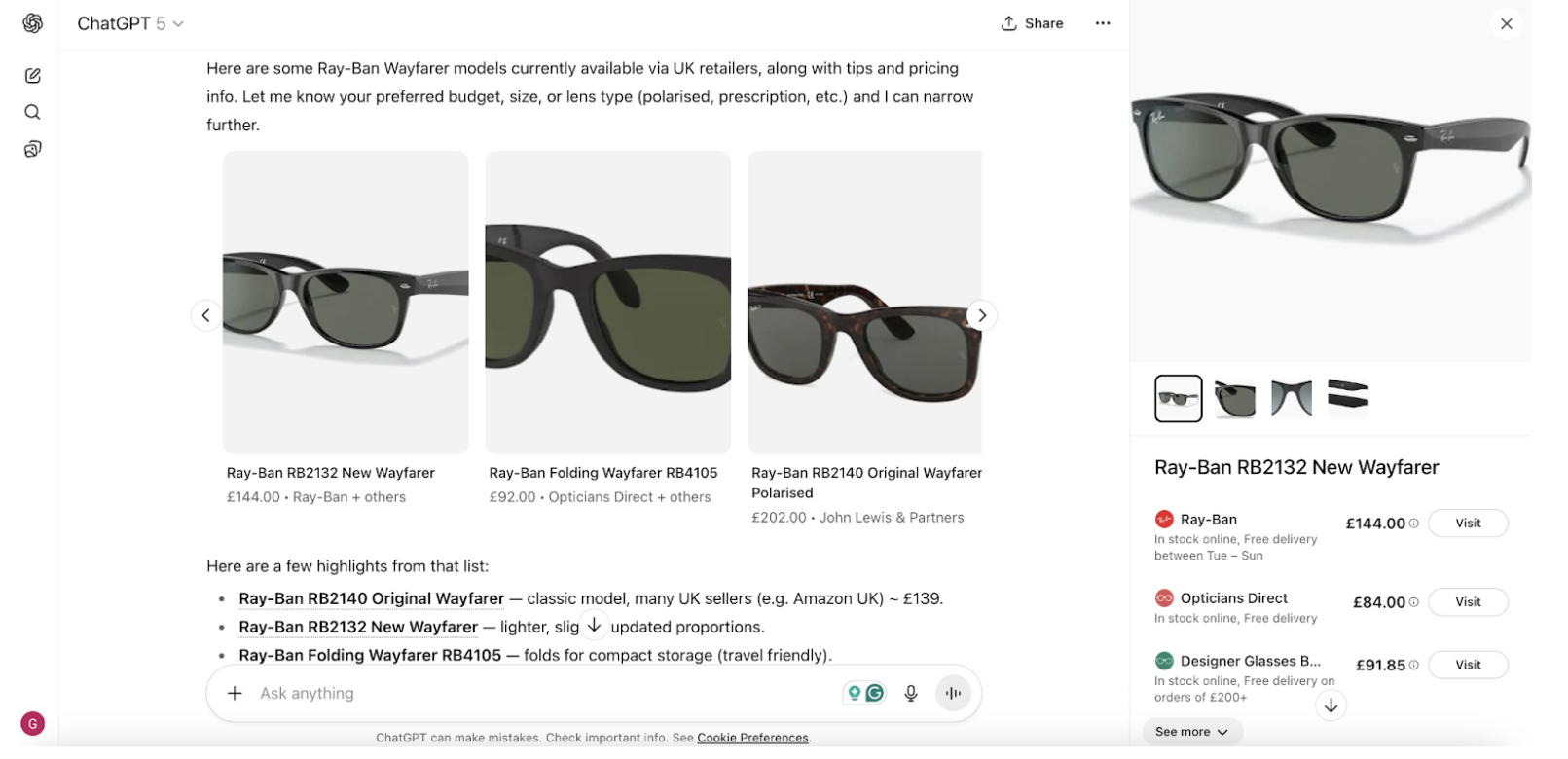
An example of a prompt within ChatGPT, which, thanks to the semantic enrichment, enables Ray-Ban to get visibility across AI search, yet this is only the start of a journey that is moving from discovery to an entire transactional journey where the agent aligns with the human and completes the purchase.
On September 29, 2025, OpenAI fundamentally altered the e-commerce landscape. With the launch of Instant Checkout, 700 million weekly ChatGPT users can now purchase products directly through conversation without ever leaving the chat interface. The purchase flow, which once required multiple page loads, form fills, and decision points, now occurs in a few taps within an AI conversation.
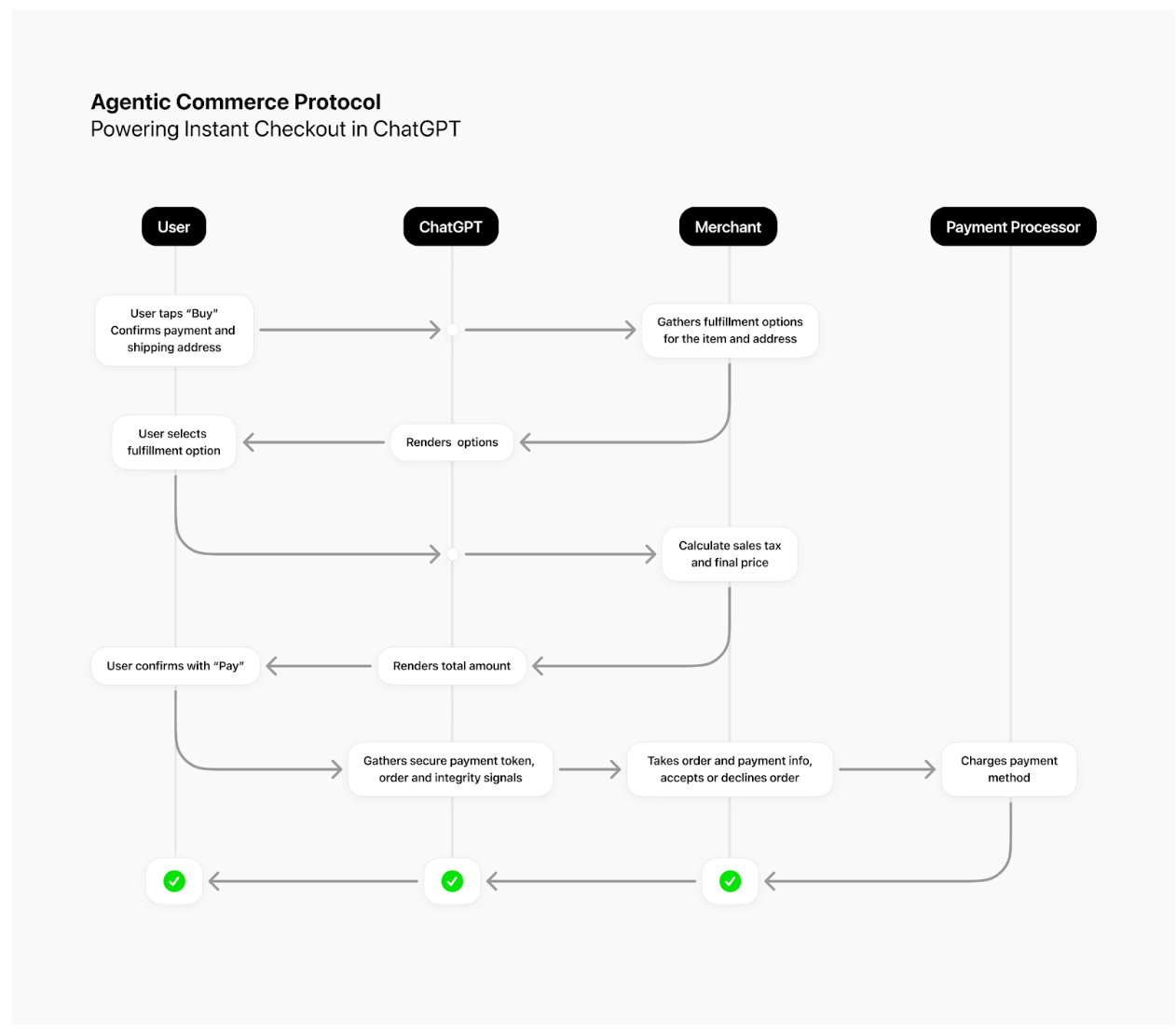
Source: OpenAI
Starting with U.S. Etsy sellers and expanding imminently to over a million Shopify merchants—including major brands like Glossier, SKIMS, Spanx, and Vuori—this marks OpenAI’s definitive pivot from information retrieval to transaction execution. ChatGPT is no longer just answering questions about products; it’s completing purchases, processing payments, and coordinating fulfillment.
But this isn’t just about OpenAI. While ChatGPT grabbed headlines, Google has been building parallel infrastructure that may prove even more comprehensive. Google’s AI Mode has deployed agentic capabilities that can search across multiple platforms, track prices over time, and automatically complete purchases via Google Pay when user-defined conditions are met. With access to more than 50 billion product listings in its Shopping Graph—refreshing 2 billion listings every hour—Google possesses data infrastructure advantages that no competitor can easily replicate.
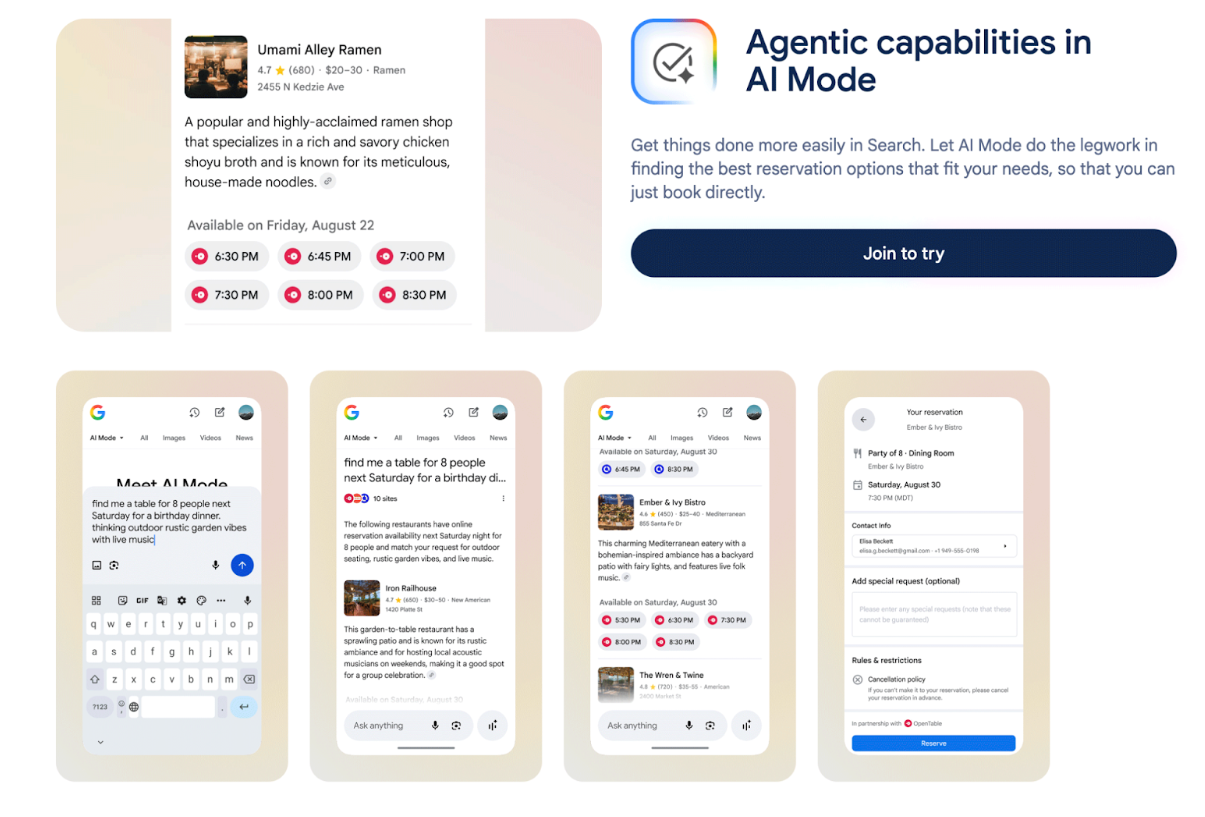
Source: X
The impact is already measurable. Data from SimilarWeb reveals something that should alarm traditional e-commerce players: ChatGPT-referred traffic converts at 11.4%, nearly double the 10.2% conversion rate of direct visits, and significantly outperforming paid search (9.3%), organic search (5.3%), email (4.6%), and social media (3.8%). The year-over-year trend from June 2024 to June 2025 shows a 45% increase in conversion rates, with particularly sharp acceleration from March 2025 onward.
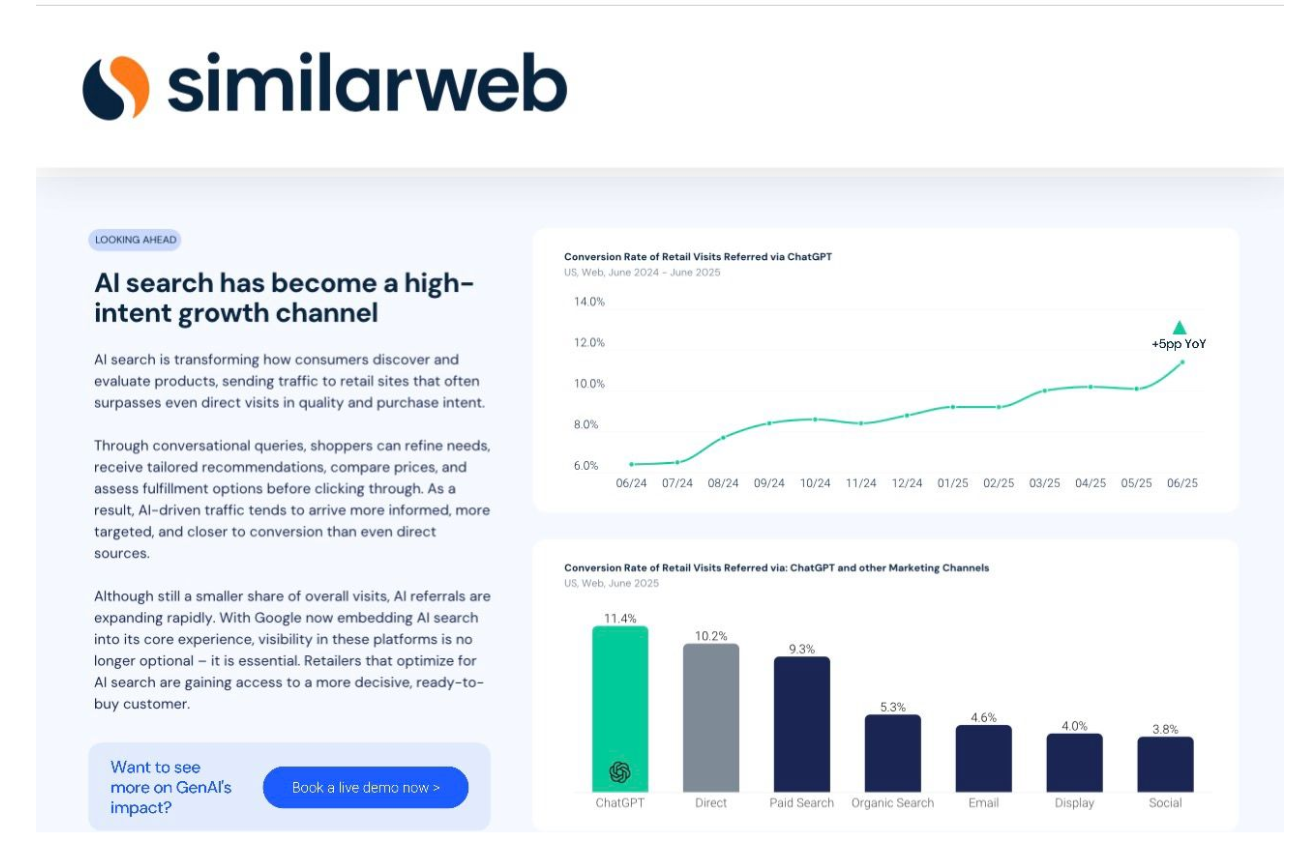
AI search has become what the industry never saw coming—not just another channel, but a high-intent growth channel that outperforms every traditional discovery method.
The implications for e-commerce are seismic. The question is no longer whether AI will disrupt commerce, but how fast and how completely it will reshape the entire value chain from discovery to payment. For e-commerce businesses—from small merchants to enterprise platforms—the adaptation window is narrow and closing rapidly.
The Convergence: When Three Giants Attack Commerce Simultaneously
OpenAI’s Instant Checkout Strategy
The mechanics of ChatGPT’s Instant Checkout reveal both sophistication and strategic ambition. When a user asks a shopping-related question—”best hiking boots under $150″ or “birthday gift ideas for a 10-year-old nephew”—ChatGPT surfaces relevant products from across the web. Product results are organic and unsponsored, ranked purely on relevance to the user, according to OpenAI’s announcement. If a product supports Instant Checkout, users can tap “Buy,” confirm order details, shipping address, and payment information, then complete the purchase without ever leaving the chat.
Behind the scenes, the transaction flows through the Agentic Commerce Protocol, co-developed with Stripe. ChatGPT acts as the user’s AI agent, securely passing information between user and merchant. The merchant handles orders, payments, and fulfillment using their existing systems—ChatGPT doesn’t process payments directly but coordinates the transaction. OpenAI takes a small merchant fee on completed purchases, establishing a commission-based revenue model that could prove transformative given the platform’s scale.
The market reaction was immediate: Etsy’s stock jumped nearly 16% on the announcement, with investors recognizing that access to 700 million weekly users represents a distribution channel that could rival or exceed traditional search engines.
The system currently supports single-item purchases, with multi-item carts and expanded regional availability slated for the coming months. But the technical foundation carries implications that extend far beyond OpenAI’s immediate implementation.
The Agentic Commerce Protocol is open-source, designed to work across platforms, processors, and business models. This isn’t a closed ecosystem—it’s an attempt to establish the rails for AI-native commerce. For merchants already processing payments with Stripe, enabling agentic payments requires as little as one line of code. Merchants using other payment processors can still participate through Stripe’s Shared Payment Token API or by adopting the Delegated Payments Spec without changing their existing infrastructure.
The strategic calculation is clear: OpenAI aims to establish itself as the standard protocol for AI commerce, not just another closed platform. If successful, this would give OpenAI a significant advantage over the entire AI-commerce ecosystem, even as competitors develop their own agent-shopping experiences.
Google’s Dual-Strategy Dominance: Playing Both Sides of the AI Commerce Revolution
The Two-Pronged Attack
While OpenAI captured media attention with its Instant Checkout announcement, Google has quietly deployed what may be the most comprehensive—and strategically sophisticated—AI commerce infrastructure in the market. The scale and multi-layered approach reveals long-term strategic planning that predates OpenAI’s announcement by months.
What makes Google’s strategy uniquely powerful is that it’s playing both sides of the AI commerce transformation simultaneously:
Centralization through Google AI Mode/Gemini — building a proprietary commerce engine that keeps users inside Google’s ecosystem.
Decentralization through the Agents-to-Payments (A2P) Protocol — creating open infrastructure that allows any AI agent to complete transactions anywhere
This dual strategy gives Google optionality that no competitor possesses. If the market consolidates around proprietary platforms, Google wins through AI Mode. If the market fragments across multiple AI agents, Google wins through A2P protocol adoption. Either way, Google captures value.
The Centralized Play: AI Mode as Commerce Engine
Google’s AI Mode now includes agentic capabilities that fundamentally compress the shopping journey. When a user asks for restaurant recommendations with multiple constraints—party size, date, time, location, cuisine preferences—AI Mode searches across multiple reservation platforms and websites, finds real-time availability, and presents a curated list of restaurants with available slots. The system then links directly to booking pages, handling the tedious work of comparing options across fragmented platforms.
The shopping applications extend this framework. Users can ask AI Mode for product recommendations using natural language queries like “cute travel bag for rainy weather trips.” AI Mode runs what Google calls a “query fan-out”—executing multiple simultaneous searches to understand what makes a bag suitable for both rainy conditions and long journeys, then synthesizing results into personalized recommendations with visual product panels that update dynamically as the conversation continues.
The agentic checkout completes the loop. Users can track product prices by tapping “track price” on any listing, setting preferences for size, color, and maximum spend. When conditions are met, Google’s agents add items to the cart on the merchant’s site and securely complete checkout with Google Pay on the user’s behalf—all with explicit user confirmation before final purchase.
The Unmatched Data Infrastructure Advantage
But Google’s true advantage isn’t any single feature. It’s data infrastructure at a scale no competitor can match. Google’s Shopping Graph now contains more than 50 billion product listings, with more than 2 billion listings refreshed every hour. This real-time product catalog, combined with integration across Google Search, Maps, Gmail, and Calendar, creates a personalization engine that improves with every interaction.
AI Mode now delivers results tailored to personal preferences based on previous conversations, places searched for or tapped on in Search and Maps. If you’ve previously searched for Italian restaurants with outdoor seating, AI Mode infers these preferences and weights recommendations accordingly. The system explicitly asks for user permission before using this context, but the competitive advantage is clear: Google isn’t just facilitating transactions; it’s building a preference graph that compounds in value over time.
The integration depth poses challenges for competitors. When users ask “what should I do this weekend in Nashville with foodie friends?” AI Mode can reference upcoming trips in Gmail, restaurant preferences from Maps history, and calendar availability to provide deeply contextualized recommendations. This cross-product data integration represents a moat that standalone AI assistants can’t easily replicate.
The Opportunity Landscape: Why This Could Be E-commerce’s Biggest Growth Channel
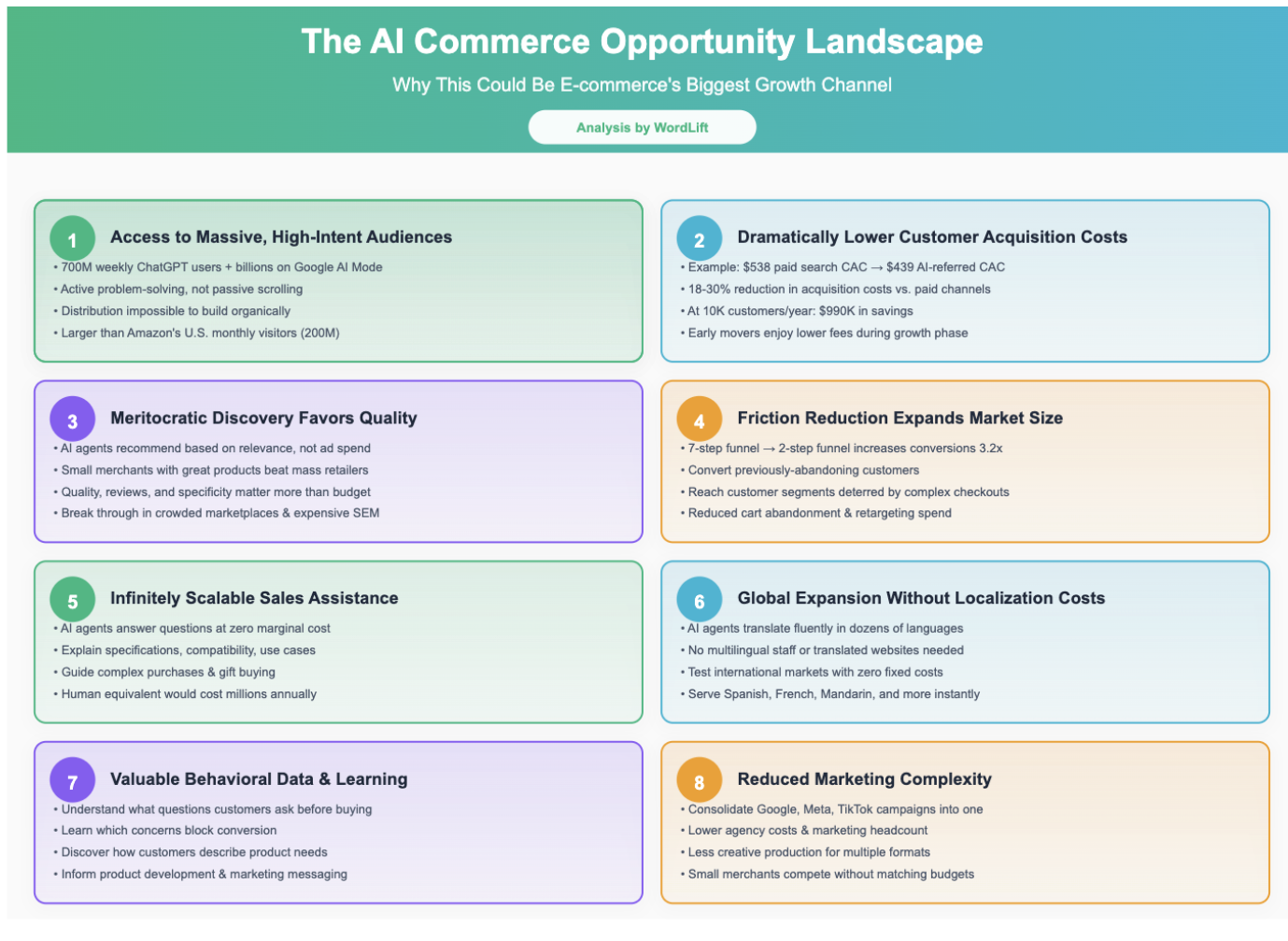
Before examining the challenges, let’s clarify the opportunity scale. This isn’t about defending existing market share—it’s about accessing entirely new customer acquisition channels with superior economics.
1. Access to Massive, Highly-Engaged Audiences
700 million weekly active ChatGPT users represents an audience larger than:
- Amazon’s monthly U.S. visitors (~200 million)
- Instagram Shopping’s active user base (~500 million)
- Pinterest’s monthly active users (~450 million)
And these users are engaging deeply. Of course, ChatGPT doesn’t yet have the extensive inventory of products that Google and Amazon have; yet, the OpenAI chatbot (which is evolving into an agent) knows everything about you, and in the short term, it might utilize memory to do what inventory can’t. In addition, ChatGPT will leverage deep integrations with players like Shopify and Etsy to start gaining traction on the inventory side.
ChatGPT already processed over 1 billion web searches in a single week, with “a huge portion” of queries related to shopping and commerce, according to OpenAI. This isn’t passive scrolling—it’s active problem-solving, where purchase intent is explicitly stated.
Google’s AI Mode adds even more scale, with integration directly into Search reaching billions of users globally. For merchants, this represents distribution access that would be impossible to build organically.
2. Dramatically Lower Customer Acquisition Costs
The conversion rate advantage translates directly to CAC (Customer Acquisition Cost) improvement, for now.
The early-mover advantage is even more pronounced. Channel costs typically increase as competition intensifies. Merchants who establish presence in AI commerce now will enjoy:
- Lower transaction fees during the growth phase.
- Algorithm advantages as platforms learn which merchants provide good experiences.
- Brand recognition as innovation leaders.
- Data advantages from understanding customer behavior in AI contexts.
3. New Product Discovery Mechanisms That Favor Quality
Traditional search and social commerce favor brands with large marketing budgets. AI agents, by contrast, make recommendations based on relevance to user needs—creating opportunities for smaller merchants with differentiated products.
A ceramics artist on Etsy competing with mass-market retailers in Google Shopping faces severe disadvantages. But when a ChatGPT user asks “unique handmade gifts for a pottery enthusiast,” the AI agent evaluates quality, uniqueness, and relevance—factors where small merchants can win.
This creates a more meritocratic discovery environment where product quality, reviews, and specificity matter more than advertising spend. Merchants who have struggled to gain visibility in crowded marketplaces or expensive paid search auctions can achieve breakthrough distribution through AI agents.
4. Friction Reduction Increases Market Size
The funnel collapse from seven steps to two doesn’t just improve conversion—it expands the addressable market. Many potential customers abandon purchases due to checkout friction, not lack of interest. By removing barriers, AI agents convert previously-lost customers.
Research consistently shows that each additional step in a purchase funnel causes 10-20% dropoff. A seven-step funnel might convert 100 initial visitors into 20 purchases. A two-step funnel converts 100 visitors into 64 purchases—a 3.2x improvement from friction reduction alone.
For merchants, this means:
- Higher conversion rates on existing traffic.
- Ability to convert previously-abandoning customers.
- Expansion into customer segments deterred by complex checkouts.
- Reduced cart abandonment costs and retargeting spend.
5. Conversation as Conversion Tool
AI agents don’t just complete transactions—they act as infinitely scalable sales assistants who can answer questions, address concerns, compare options, and guide purchase decisions. This is particularly valuable for:
- Complex products: Explaining technical specifications, compatibility, or use cases .
- Considered purchases: Addressing concerns about sizing, quality, or suitability.
- Gift buying: Helping users navigate unfamiliar product categories.
- Research-intensive categories: Synthesizing reviews, comparing options, explaining differences.
A human customer service team capable of handling this at scale would cost millions annually. AI agents provide this consultation layer at zero marginal cost, improving customer experience while increasing conversion.
6. Global Expansion Without Localization Costs
AI agents communicate fluently in dozens of languages, automatically translating product information, answering questions, and facilitating purchases across linguistic barriers.
A U.S. merchant previously limited to English-speaking markets can suddenly serve:
- Spanish-speaking customers in Latin America.
- French-speaking customers in Europe and Africa.
- Mandarin-speaking customers in China and Southeast Asia.
- Dozens of other linguistic markets.
This happens without hiring multilingual staff, translating websites, or building regional operations. The AI agent handles localization automatically, dramatically reducing international expansion costs.
7. Data and Learning Advantages
Early adopters gain access to behavioral data about how customers interact with AI agents:
- What questions they ask before purchasing.
- Which concerns block conversion.
- How they describe product needs.
- What comparison factors matter most.
This data is invaluable for:
- Product development informed by actual customer language.
- Marketing messaging that addresses real concerns.
- Competitive positioning based on what customers actually compare.
- Content strategy optimized for AI agent understanding.
Merchants who wait will enter the channel without these insights, at a significant disadvantage.
8. Reduced Marketing Complexity
Current e-commerce marketing requires managing:
- Google Ads campaigns across search, shopping, display.
- Social media advertising on Meta, TikTok, Pinterest.
- Email marketing and automation.
- Affiliate programs.
- SEO optimization.
- Marketplace advertising (Amazon, Etsy, etc.).
AI agent commerce consolidates many of these into a single integration. Instead of optimizing campaigns across six platforms, merchants optimize product data and let AI agents handle distribution. This reduces:
- Agency costs and internal marketing headcount.
- Campaign management overhead.
- Creative production for multiple formats.
- Platform-specific expertise requirements.
For small to mid-size merchants, this simplification is transformative—allowing them to compete with larger companies without matching their marketing budget.
Optimizing for the Triple Threat
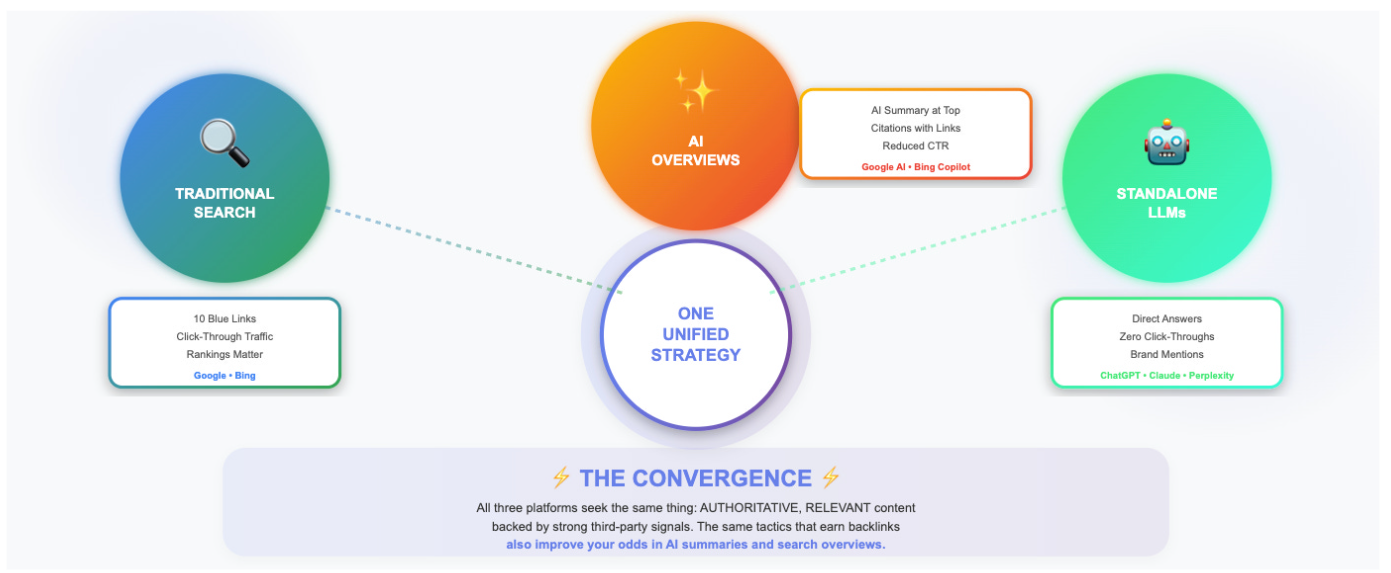
The integrated approach doesn’t require three separate content strategies—the same principles that work for SEO also optimize for answer engines and generative AI citation, giving you maximum visibility across all search modalities.
Whether you’re using Google or ChatGPT, both platforms strive to surface the most authoritative, relevant content on a given subject. They do this by identifying which entities (brands or sources) have provided robust subject matter expertise backed by strong third-party authority signals.
This convergence means the same tactics that earn coverage, backlinks, and social engagement also improve your odds in AI summaries and search overviews. Authority (citations and mentions), originality (first-party research and insights), and trust (consistency across platforms and personas) are now essential inputs for large language models.
The Technical Requirements: What AI Agents Demand from E-commerce Infrastructure
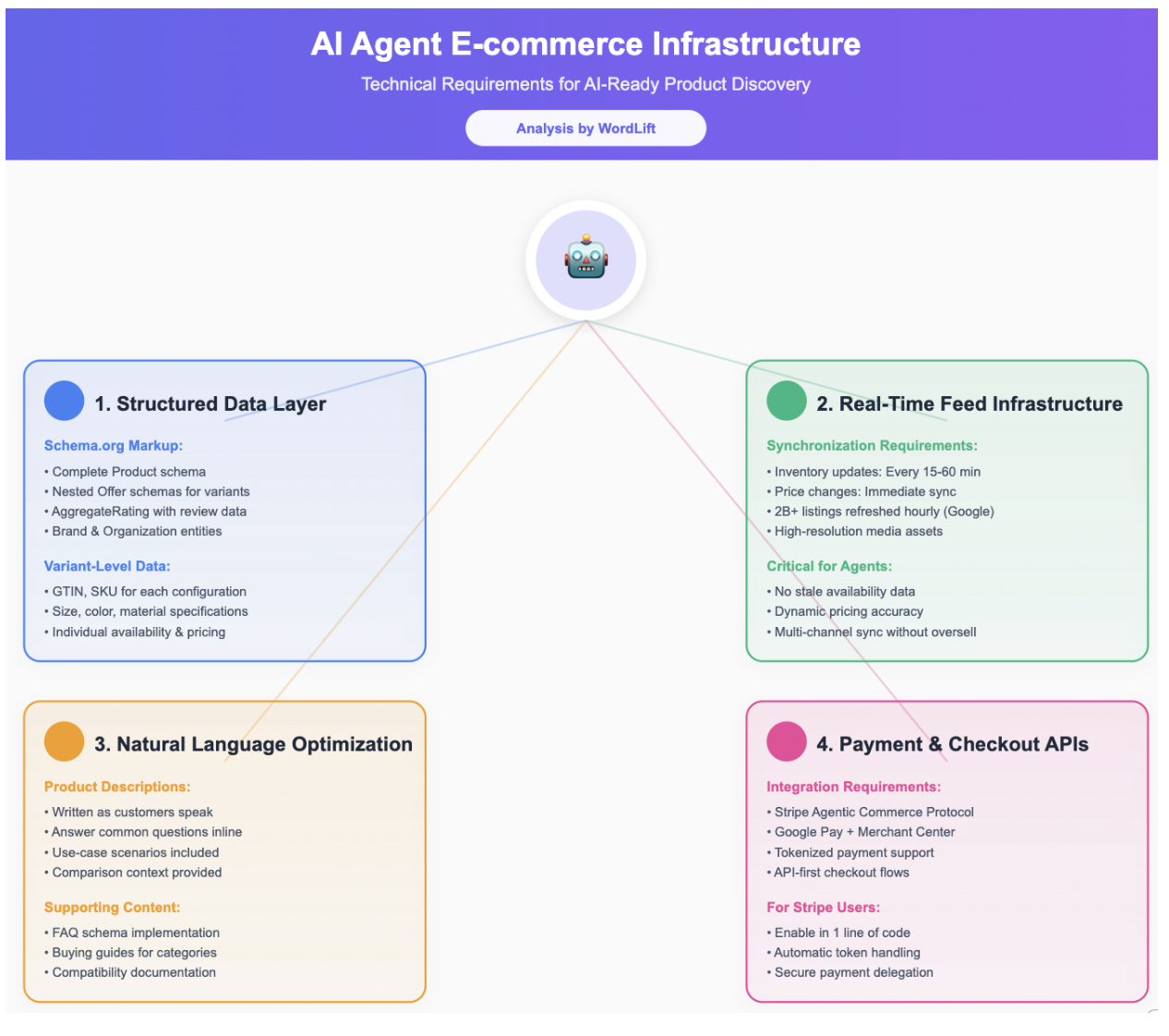
Structured Data as Survival Mechanism
In the AI-agent era, if your product can’t be parsed, it doesn’t exist. This isn’t hyperbole—it’s the fundamental requirement for visibility in agent-mediated commerce.
Traditional SEO allowed for ambiguity. A poorly structured product page with weak metadata might still rank if the content was strong and backlinks were authoritative. AI agents operate differently. They parse structured representations of products to make rapid comparisons across thousands of options. Missing attributes, incomplete schemas, or inconsistent data formatting don’t just hurt rankings—they result in complete exclusion from consideration.
The technical bar has risen dramatically, and the requirements are specific:
Schema.org Markup Requirements:
- Complete Product schema with price, availability, specifications, images, and hierarchical categorization.
- Nested Offer schemas for all variants (size, color, material) with individual SKUs, pricing, and availability.
- AggregateRating data with review counts, average ratings, and ideally distribution of ratings.
- Brand and Organization entities with proper validation, relationships, and authority signals.
According to guidance for e-commerce sellers: “Ecommerce sellers should ensure their product listings and checkout flows are compatible with agentic interactions by submitting structured product data that clearly defines variants such as GTIN, size, color, and material. Google’s AI needs this detail to allow users to track and buy specific configurations—not just the parent product.”
The variant-level specificity is critical. When a user asks an AI agent to “track this product in size medium, blue, and notify me if it drops below $50,” the agent needs machine-readable data that identifies that exact configuration. Parent-level product data without variant specifications makes this impossible.
Feed Infrastructure Requirements:
- Real-time inventory synchronization: Google’s Shopping Graph refreshes more than 2 billion listings every hour. Outdated availability causes friction in checkout or prevents surfacing altogether.
- Variant-level attribute specification: Every configuration needs complete data—not just the parent product.
- Pricing accuracy at scale: Dynamic pricing must update in feeds immediately, as agents compare prices in real-time across merchants.
- Rich media assets: High-resolution images, multiple angles, lifestyle photography, and ideally 360-degree views.
The synchronization requirement represents a significant operational challenge. Many e-commerce systems batch-update product feeds every few hours or even daily. In agent-mediated commerce, this latency means agents may show out-of-stock products or incorrect prices, leading to customer frustration and lost sales when checkout fails.
Payment and Checkout Integration:
- Google Pay and Google Merchant Center integration: Agentic checkout flows rely on these systems to add items to cart and complete purchases securely.
- Stripe integration for Agentic Commerce Protocol: For merchants already on Stripe, enabling agentic payments requires as little as one line of code.
- Tokenized payment support: Using Stripe’s Shared Payment Token API or adopting the Delegated Payments Spec for merchants using other processors.
- API-first checkout flows: Agents must be able to programmatically navigate checkout without human form-filling.
The protocol architecture diagram from OpenAI shows the flow: User confirms purchase → ChatGPT gathers secure payment token → Merchant’s backend receives order via ACP → Merchant calculates tax and final price → Merchant accepts/declines via their payment processor → Completion confirmation flows back through the chain.
This entire flow must work programmatically, without manual intervention. E-commerce platforms built around human form-filling and multi-page checkout sequences need architectural updates to support agent-mediated transactions.
The Protocol Adoption Decision: First-Mover Advantage vs. Platform Lock-In
OpenAI is open-sourcing the Agentic Commerce Protocol so that more merchants and developers can begin building their integrations. When ready to make products available for purchase through ChatGPT, merchants can apply through OpenAI’s merchant portal.
The decision to integrate early carries both risk and opportunity—a familiar pattern for merchants who remember the early days of Amazon Marketplace, Facebook Shops, or Instagram Shopping.
Early adopters gain:
- Access to 700 million weekly users actively using ChatGPT for product discovery.
- Preferential positioning during the learning phase as AI models learn which merchants provide reliable fulfillment and good customer experiences.
- Input into protocol evolution through feedback loops with OpenAI and Stripe.
- Data advantages from understanding how AI-mediated traffic differs from traditional channels.
- Brand recognition as an innovation leader willing to adopt emerging commerce channels.
But integration requires accepting:
- Engineering resources for API implementation, testing, and monitoring.
- Transaction fees (currently undisclosed percentage) on every completed purchase.
- Ceding control over the final purchase environment, product presentation, and competitive context.
- Trust in platform stability and OpenAI’s long-term commitment to the protocol.
- Dependency risk if the platform becomes the primary or sole distribution channel.
The decision matrix mirrors the early days of Amazon Marketplace: adopt early and gain distribution advantage, but accept platform dependency. Delay, and potentially lose access to the fastest-growing discovery channel in e-commerce.
The open-source aspect provides some hedge against lock-in. If the Agentic Commerce Protocol achieves wide adoption across multiple AI platforms—Anthropic’s Claude, Google’s Gemini, Meta’s AI assistants, and others—then integration becomes platform-agnostic infrastructure rather than OpenAI-specific dependency. But if OpenAI’s implementation diverges from the open standard or other platforms develop competing protocols, early adopters may find themselves supporting multiple incompatible systems.
The calculus differs by merchant type. For small Etsy sellers, integration is simple and provides access to an audience they couldn’t reach otherwise. For major brands with significant direct-to-consumer operations, the decision involves strategic questions about brand control, customer data ownership, and long-term platform power dynamics.
The Bottom Line: The Biggest E-commerce Opportunity Since Mobile
The convergence of ChatGPT’s Instant Checkout, Google’s AI Mode shopping features, and the broader shift toward agentic commerce represents the most significant growth opportunity in e-commerce since the smartphone revolution—and the adaptation window is narrow.
The evidence is compelling:
The economics are exceptional: AI-referred traffic converts at 11.4%, nearly double traditional direct traffic, with year-over-year growth of 45% and accelerating adoption. This translates directly to 18-30% reductions in customer acquisition costs compared to paid search and social advertising.
The scale is massive: 700 million weekly ChatGPT users plus billions using Google AI Mode represents distribution access that would cost hundreds of millions to build organically.
The timing is optimal: We’re in the land-grab phase where early adopters establish advantages that compound over time—algorithm preferences, brand recognition, operational expertise, and data insights that later entrants can’t easily replicate.
The technical requirements create moats: Comprehensive structured data, real-time feeds, and API-first architecture sound like costs but function as competitive advantages. Excellence in these areas immediately differentiates merchants from the 90%+ who haven’t invested in AI-ready infrastructure.
The platform incentives align: Transaction fee revenue provides platforms with sustainable business models, creating long-term commitment. Unlike ad platforms that can cut off traffic overnight, AI commerce protocols are open-source and multi-platform, reducing lock-in risk.
Yes, there are legitimate challenges to manage:
- Platform dependencies that require strategic balancing.
- Margin pressure from transaction fees.
- Reduced brand visibility when purchases happen in-agent.
- The need to maintain excellence across both AI and traditional channels.
But these challenges are manageable with proper strategy, while missing the opportunity is not.
For e-commerce businesses—from individual merchants to enterprise retailers—the adaptation window is narrow. The companies that will thrive in agent-mediated commerce are those that recognize this isn’t about defensive positioning. It’s about offensive opportunity capture.
The winners will be merchants who:
- Move decisively to establish early presence in AI commerce before competition matures.
- Invest in data infrastructure that creates sustainable competitive advantages.
- Build hybrid channel strategies that leverage AI agents for acquisition while maintaining owned-property relationships.
- Focus on quality signals that AI agents reward—reviews, expertise, uniqueness, trust.
- Test and learn rapidly to understand this new customer behavior before others.
The technical requirements are clear: structured data, real-time feeds, API-first architecture, and protocol integration. The strategic choices require nuance: which products to offer through agents, how to balance channel dependencies, where to invest in brand-building that transcends platforms.
But the fundamental decision is simple: participate early and capture advantage, or delay and fight for scraps after the land grab ends.
The e-commerce revolution took two decades to reshape retail. The mobile commerce revolution took less than a decade. The AI commerce revolution may reshape the industry in 2-3 years.
The data is clear: 11.4% conversion rates, 45% year-over-year growth, 700 million weekly users. This isn’t an experiment. It’s not a niche channel. It’s rapidly becoming the primary way consumers discover and purchase products online.
The question isn’t whether your business will eventually participate in AI commerce—it’s whether you’ll be positioned to capture the early-mover advantages that define market leaders, or playing catch-up while competitors who move faster build insurmountable moats.
The transactional web is being rewritten. The only question is whether your business will help write the new architecture or be forced to operate within systems built by others.
The opportunity window is open. It won’t stay open long.